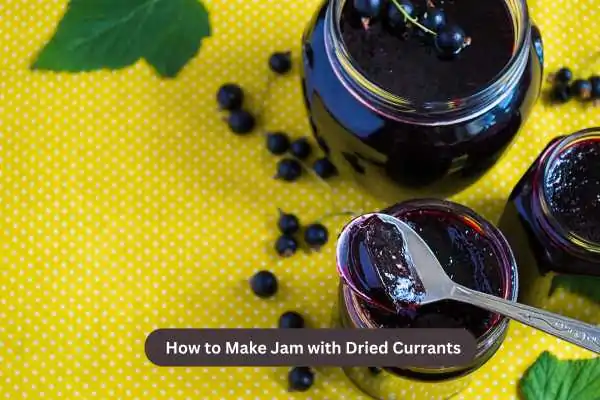Jam-making is a long-standing tradition in many UK kitchens, and while most recipes use fresh fruit, dried currants offer a delightful twist. They produce a rich, intense flavour, and their natural sweetness means you can reduce added sugar compared to other jams.
If you’ve got a packet of dried currants in the cupboard, you can transform them into a delicious, shelf-stable jam in just a few steps. This guide will walk you through the process, from ingredient selection to storage, so you can enjoy homemade jam that tastes like it came from a countryside market.

Why Use Dried Currants for Jam?
Dried currants are small, sweet berries—usually made from Black Corinth grapes—that are naturally high in sugar and flavour. Because they’re dehydrated, they store well year-round, making them perfect for jam-making when fresh currants are out of season.
They also rehydrate beautifully, creating a thick, rich texture that works well for spreading on toast, scones, or even stirring into porridge.
Ingredients You’ll Need
For a small batch of dried currant jam, you’ll need:
-
250g dried currants
-
250ml water (plus extra if needed)
-
200g granulated sugar (or adjust to taste)
-
1 tbsp lemon juice (for acidity and preservation)
Optional flavour additions:
-
½ tsp ground cinnamon for warmth
-
1 tsp vanilla extract for depth
Step-by-Step Method
1. Rehydrate the Currants
Place the dried currants in a medium saucepan. Add the water and bring to a gentle simmer over medium heat. Stir occasionally and let the currants absorb the water for around 10–15 minutes, until they plump up and become soft.
If the currants are still a little dry, add more water in small amounts until they’re fully rehydrated.
2. Add Sugar and Lemon Juice
Once the currants are rehydrated, stir in the sugar and lemon juice. The lemon juice not only balances sweetness but also helps the jam set by working with the natural pectin in the fruit.
Continue heating on medium, stirring until the sugar has fully dissolved.
3. Simmer and Thicken
Reduce the heat to low and let the mixture simmer gently for 15–20 minutes. Stir regularly to prevent sticking.
As the jam thickens, you’ll notice the mixture becoming glossy and slightly sticky. To check if it’s ready, spoon a little onto a chilled plate—if it wrinkles when you push it with your finger, the jam has set.
4. Blend for a Smoother Texture (Optional)
If you prefer a smoother jam, you can blend the mixture using a hand blender directly in the pan, or transfer it to a blender carefully while hot. This step is optional, as some people enjoy the rustic texture of whole currants.
5. Jar and Store
Pour the hot jam into sterilised glass jars, leaving about 1cm of space at the top. Seal with sterilised lids immediately.
Allow to cool completely before storing. Kept in a cool, dark cupboard, the jam should last up to 6 months unopened. Once opened, store in the fridge and consume within 3 weeks.
Tips for Success
-
Sterilise properly: Wash jars and lids in hot soapy water, rinse well, then place in a low oven (around 120°C) for 15 minutes before filling.
-
Adjust sweetness: Taste before adding all the sugar; dried currants can be naturally very sweet.
-
Experiment with spices: Nutmeg, cloves, or even a touch of ginger can give your jam a unique flavour profile.
-
Mind the consistency: If your jam is too thick, add a splash of water during cooking. If too thin, cook for a few extra minutes.
Serving Suggestions
Homemade dried currant jam is wonderfully versatile. Try it:
-
Spread over warm buttered toast or crumpets.
-
Layered in a Victoria sponge cake for a fruity twist.
-
Swirled into Greek yoghurt for a quick breakfast.
-
Paired with cheese and oatcakes for a savoury-sweet snack.
-
As a filling for jam tarts or thumbprint biscuits.
Why Make Your Own Jam?
Making jam at home gives you complete control over what goes into your jar—no artificial preservatives, no unnecessary additives, and the ability to tailor sweetness to your liking. It’s also a satisfying skill that connects you to traditional kitchen craft, and it makes a thoughtful homemade gift for friends and family.
Plus, with dried currants, you can make jam any time of year without relying on seasonal produce.
Final Thoughts
Learning how to make jam with dried currants is straightforward, rewarding, and perfect for anyone who enjoys rich, flavourful spreads. The deep, fruity taste pairs beautifully with both sweet and savoury dishes, and the process is simple enough for beginners.
Next time you see dried currants in the baking aisle, pick up a packet and try this recipe—you might just find it becomes a new favourite in your pantry.

